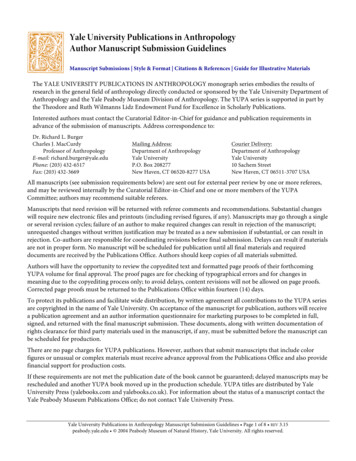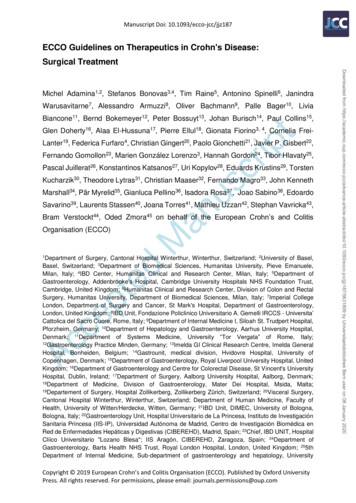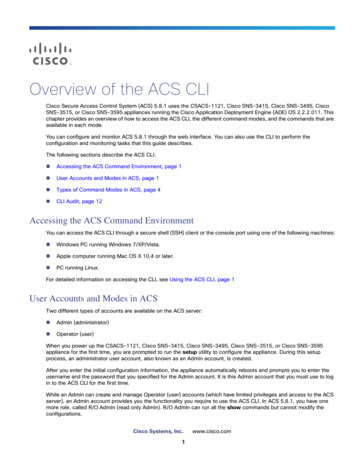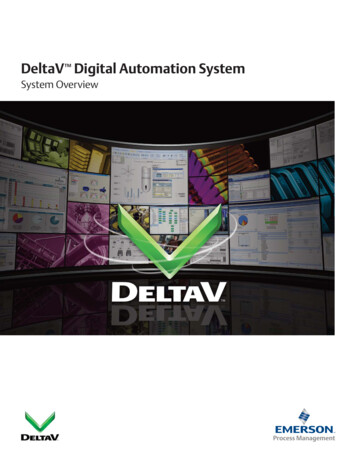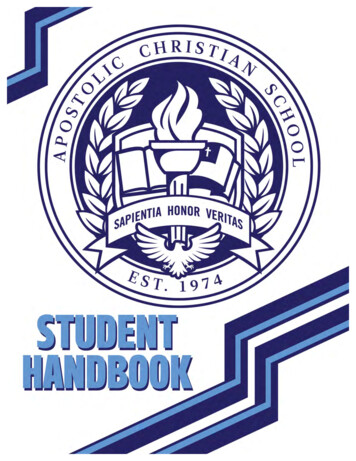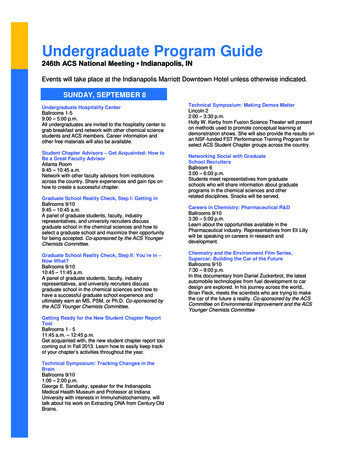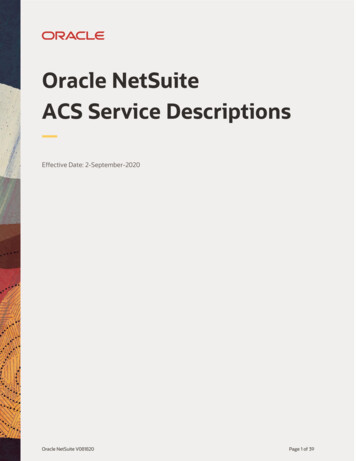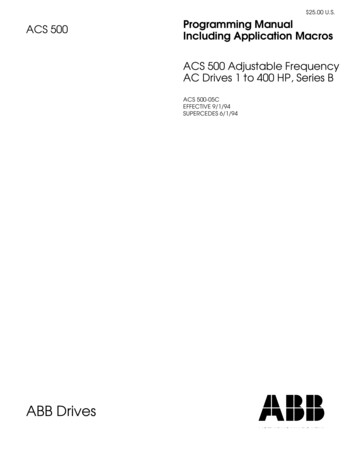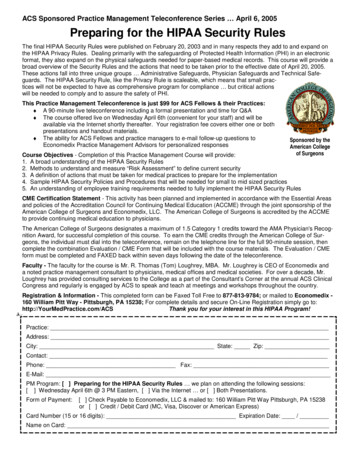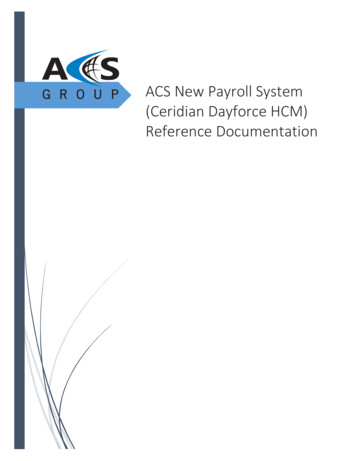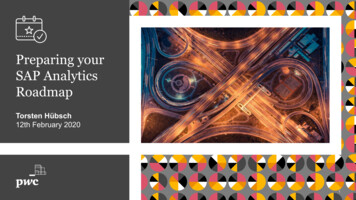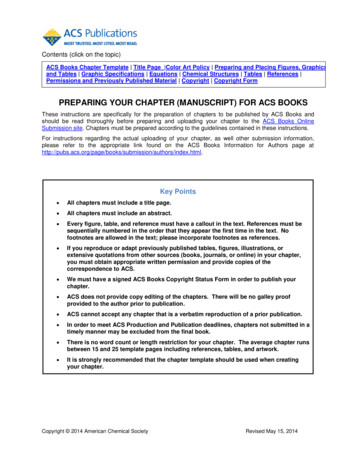
Transcription
Contents (click on the topic)ACS Books Chapter Template Title Page Color Art Policy Preparing and Placing Figures, Graphicsand Tables Graphic Specifications Equations Chemical Structures Tables References Permissions and Previously Published Material Copyright Copyright FormPREPARING YOUR CHAPTER (MANUSCRIPT) FOR ACS BOOKSThese instructions are specifically for the preparation of chapters to be published by ACS Books andshould be read thoroughly before preparing and uploading your chapter to the ACS Books OnlineSubmission site. Chapters must be prepared according to the guidelines contained in these instructions.For instructions regarding the actual uploading of your chapter, as well other submission information,please refer to the appropriate link found on the ACS Books Information for Authors page s/index.html.Key Points All chapters must include a title page. All chapters must include an abstract. Every figure, table, and reference must have a callout in the text. References must besequentially numbered in the order that they appear the first time in the text. Nofootnotes are allowed in the text; please incorporate footnotes as references. If you reproduce or adapt previously published tables, figures, illustrations, orextensive quotations from other sources (books, journals, or online) in your chapter,you must obtain appropriate written permission and provide copies of thecorrespondence to ACS. We must have a signed ACS Books Copyright Status Form in order to publish yourchapter. ACS does not provide copy editing of the chapters. There will be no galley proofprovided to the author prior to publication. ACS cannot accept any chapter that is a verbatim reproduction of a prior publication. In order to meet ACS Production and Publication deadlines, chapters not submitted in atimely manner may be excluded from the final book. There is no word count or length restriction for your chapter. The average chapter runsbetween 15 and 25 template pages including references, tables, and artwork. It is strongly recommended that the chapter template should be used when creatingyour chapter.Copyright 2014 American Chemical SocietyRevised May 15, 2014
IntroductionThese instructions will help provide consistency within the book while allowing authors to use their ownword-processing capabilities to produce a high-quality document.It is important that you thoroughly proofread and copy edit your chapter before submitting it becausethese tasks are not performed by ACS Production. Also, in response to faster publishing demands, ACSdoes not provide authors with a galley proof of the chapter prior to publication. Please ensure that allnecessary changes are incorporated prior to submitting your revised chapter. Once your chapter hasbeen accepted for publication, ACS Production will provide the following: Make necessary formatting changes (i.e., margins, leading, size, and placement of figures andtables) to the text to better fit the electronic and print specificationsTag the data elements of your chapter for the electronic productPrepare figures and graphics for both the electronic and print productsSequentially number the pages and add the chapter numberCreate subject and author indexesWe encourage authors to refer to The ACS Style Guide for a general discussion of the principles andpractices of scientific publishing. An electronic version can be obtained by creating an account with ACSChemWorx. For information on purchasing a print copy of The ACS Style Guide, go to Oxford UniversityPressGuidelines for Preparing Your ChapterChapters must be prepared according to the guidelines contained in these instructions. ACS Books hasprovided a template for your use. It will provide a good representation of the way your chapter will look inthe published PDF.Instructions for Using the ACS Books Chapter TemplateDownload and save to your computer the newest version of the template from the ACS Books Website, and then open the file. A new document based on the template will open.1. Enter your text into the file in one of three ways: Type directly into the template. Cut and paste from another document. Use the menu command for Insert File to import a previously created document.2. View the “Styles” palette by clicking on the Add-Ins menu or by clicking on the dropdown arrowfor the Styles category on the ribbon, as highlighted in green below.Copyright 2014 American Chemical SocietyRevised May 15, 2014
3. Apply the appropriate style to each item in your document. The template contains preset "styles"for formatting each item likely to appear in a chapter. The style names describe the items (suchas "Abstract" or "Heading 1") that they format.4. When you have finished formatting the text, proceed with adding figures, equations, tables, andother elements of your chapter.Creating the Title Page1. Chapter Title2. Author Names The list of author names should include each author’s first name or initials before the familyname. Do not use all caps.The corresponding author’s name should be accompanied by an asterisk (*)Example: J. S. Smith*All chapters must include the e-mail address of the corresponding author after the author’saddress line on the title page of the chapter.If authors are from more than one affiliation, use superscript numbers to link the authors’ namesand their affiliations. If multiple affiliations are given, identify the affiliation for each author.Every author affiliation must include a mailing address.Example: Department, university or company, 111 Apple Street, New York, NY 10000.Space at the top and bottom of the title page (and only the title page) is reserved for ACSProduction use. This space is clearly marked in the template file; do not type in this reservedspace.3. AbstractAll chapters must include an abstract. The abstract must be placed immediately after the author namesand addresses on the title page. The abstract must be one paragraph, concise, self-contained, andcomplete enough to appear separately in abstract publications.Copyright 2014 American Chemical SocietyRevised May 15, 2014
Creating Section HeadingsThe headings for major sections of your chapter should not be lettered or numbered. Only threelevels should be used.Color Art PolicyPlease read this section carefully if you are submitting color figures or graphics with yourchapter. Authors are not charged for the publication of their color figures and graphics thatappear in the electronic version. Any artwork that is submitted to ACS Books in color will be publishedon the Web in color, with no cost to the author.For the print version, it is our policy to split the costs of printing color art with the author. Duringthe submission of your chapter, you will be asked to indicate your color preference. If you do notspecifically indicate your desire to use color (and provide billing information) at that time, all of yourimages will be printed in grayscale, even if they were originally submitted in color.Many variables impact the cost of printing a figure or graphic in color, including how many other pieces ofart are in the book, how large the pieces of art are. Therefore, ACS Books cannot provide exact estimatesregarding the cost for which authors will be responsible should they elect to use color in the print versionof the book. Contact books for the general pricing structure.Preparing and Placing Figures, Graphics, and TablesAll submitted images for figures, schemes, tables, equations, and so forth should be clear, legible,and concise. Please see the examples below of illegible graphics. All submitted images will betreated as graphics. There will be no modifications of graphics except for sizing. Please make surethat all images are readable. The acceptable graphic file format is TIFF.Examples of illegible graphics:Copyright 2014 American Chemical SocietyRevised May 15, 2014
Copyright 2014 American Chemical SocietyRevised May 15, 2014
Figure Citations in TextEvery figure must be cited in the text. Figures should be numbered consecutively using Arabicnumerals. When referring to a figure in the text, write out the word “Figure” and use the number.Example: As shown in Figure 3, the polymer surface has begun to deteriorate.Figure Placement and SubmissionThe acceptable graphic file format is TIFF. Please use one of the following options for figureplacement and submission.Provide the figures as part of the text: The preferred submission procedure is to embedgraphic TIFF files in the manuscript text of the Word document by copying the graphics fromthe graphics program window and pasting them directly into the manuscript. Do not resizethe graphic after it has been pasted into the manuscript. Do not wrap text around or on thesides of figures. Make sure that the complete figure caption is included beneath the figure.Figures should be placed after their citation in the text and as close to the first mention aspossible.Provide the figures at the end of the text: Another option is to submit individual graphicfiles at the end of the manuscript text in the Word document. If this is done, ensure the filesare named based on graphic function (i.e., Scheme 1, Figure 5, and Table 3). Labeling of allfigure parts must be present, and the parts should be assembled into a single graphic.Provide the figures separately from the text: If you must provide the figures separately asindividual files rather than embedding them in the manuscript, choose Graphic forManuscript as the file designation during the submission process. ACS Books will adjust thesize of all figures so that it is appropriate. During production, the figures will be placed asclose to the first mention as possible.Figure CaptionsFigure captions and titles should not be included in the graphic.A figure caption should be placed immediately below its figure. Captions begin with the word“Figure” followed by the figure number.Figure captions should be concise. Lengthy discussions of reaction conditions or data interpretation,for example, should be incorporated into the text. If you are supplying your figures separately, placethe figure captions in order at the end of the manuscript file.Graphic SpecificationsResolutionAll TIFF files (either embedded in the manuscript, at the end of the manuscript, or submitted asindividual files) should have the following resolution requirements: Black and white line art: 1200 dpi Grayscale art (a monochromatic image containing shades of gray): 600 dpiCopyright 2014 American Chemical SocietyRevised May 15, 2014
Color art (CMYK color mode): 300 dpio The CMYK and resolution requirements are essential for producing high-qualitygraphics within the published manuscript. Graphics submitted in RGB or at lowerresolutions may be used. However, the colors may not be consistent and the graphicsmay be of poor quality, respectively.o Most graphic programs provide an option for changing the resolution when you aresaving the image. The best practice is to save the graphic file at the final resolutionand size using the program used to create the graphic.SizingAll graphics should be sized consistently regardless of if they will be monochrome, grayscale, orcolor. For best results, submit graphics in the actual size at which they should appear in thepublished version. The general guidelines for sizing are: Text that is the main focus in a graphic should be sized at 5 points when possible but maybe sized slightly larger or smaller based on graphic composition; text in insets can besmaller. Consistently sizing letters and labels in graphics throughout your manuscript willhelp ensure consistent graphic presentation for publication. When sizing chemical structures, six-membered rings should be sized consistently; idealring size is 18 points. Instances where there are multiple text sizes in a graphic should be handled in referenceto the other graphics in the paper keeping in mind consistency. Size range for the width of the final graphic is 120–324 points ( 10–27 picas), with theexception of graphics that are equations; the maximum width for equations is 300 points(25 picas). Size range for the height of the final graphic should not exceed 552 points (46 picas),including the space needed for captions.EquationsAll displayed equations will be processed as graphics by ACS Book Production, including theequation number associated with the equation.TablesTable GraphicsAny table that cannot be reproduced as keyable text will be processed as a graphic by ACS BookProduction. Tables in which the table body is extensive may be split into more than one piece. Ifnecessary, ACS Book Production will rotate the table on the page, so the graphic can have a finalwidth of 46 picas.Table Citations in TextEvery table must be cited in the text. Tables should be numbered consecutively. When referring to atable in the text, write out the word “Table” and use the number.Example: The information is listed in Table 3.Copyright 2014 American Chemical SocietyRevised May 15, 2014
Table Design Each table should have a title, beginning with the word “Table”, followed by a shortdescriptive title. Table titles should be placed immediately above the table. Use vertical columns for presenting data wherever possible and provide column heads foreach column of data. When presenting numerical data, align the decimal points. If this is not possible, centerthe entry. For numbers less than 1, a zero ordinarily precedes the decimal point (e.g., 0.5). Indicate table footnotes by using superscript lowercase italic letters. Do not use shading or colored fonts. Tables with embedded graphics will be processed as graphics and sized appropriately.Table PlacementPlace small tables within the text. Otherwise, complete the page with text and place the table on thenext page. If the tables are oversized, ACS Production will reduce them and place them after theircallouts or pr
the figure captions in order at the end of the manuscript file. Graphic Specifications Resolution All TIFF files (either embedded in the manuscript, at the end of the manuscript, or submitted as individual files) should have the following resolution requirements: Black and white line art: 1200 dpi
